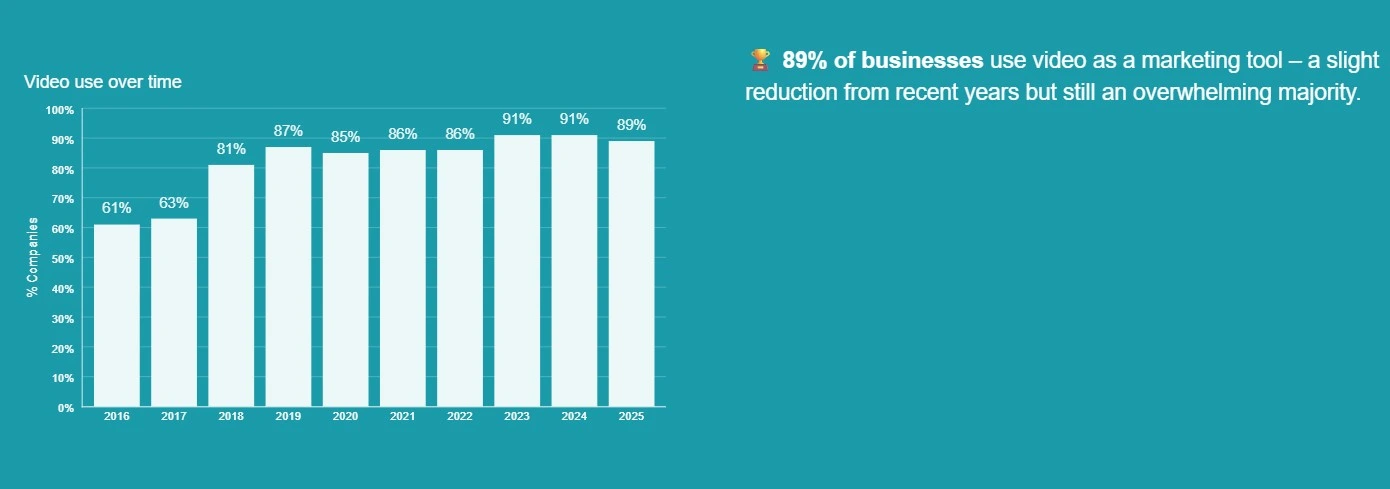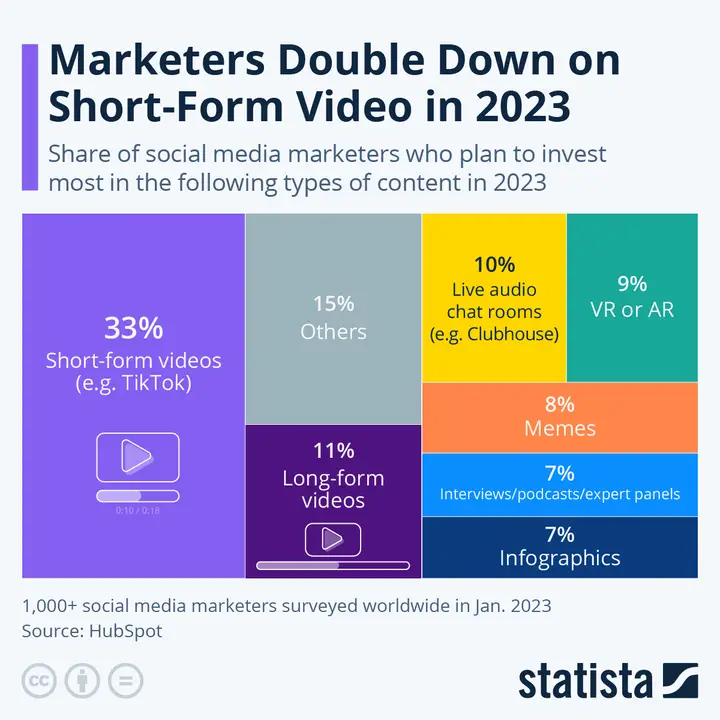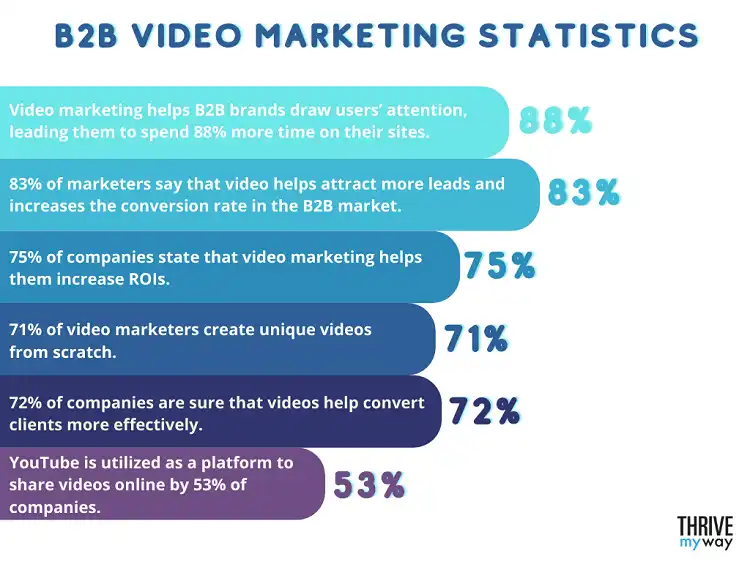Listen to article
In a world saturated with content, marketers are constantly seeking the most effective ways to capture and retain audience attention. While static content like images and text have long been staples, video has emerged as a powerful and increasingly dominant force. But where exactly does video outperform static content, and why should marketers prioritize it in their strategies?
It’s no longer enough to simply create content; businesses need to understand which formats resonate best with their target audience and deliver the most impactful results. From driving website traffic and boosting sales to enhancing user understanding and generating leads, video offers a multitude of advantages that static content simply can’t match.
In this article, we’ll explore the key areas where the performance of video is superior to static content, backing up each point with compelling statistics.
Decoding Consumer Video Habits and Expectations
The way audiences consume content has shifted dramatically, with video emerging as the clear frontrunner in capturing attention and conveying information. Whether it’s a quick product overview or an engaging tutorial, video has become the go-to medium for consumers seeking fast, digestible content. Leveraging these trends can help brands not only speak the language of their audience but also build stronger, lasting connections. Here are some critical insights that highlight why video reigns supreme:
- A notable 69% of consumers prefer to learn about products or services through short videos, proving how effective this format is for delivering concise and engaging information. Source
- Online video consumption has become an integral part of daily life, with 78% of people watching videos weekly and 55% engaging with them every single day. Source
- The appetite for video is far from saturated—85% of consumers say they want to see even more video content from brands, signaling a growing opportunity for marketers. Source
Key Takeaway
These data points aren’t just statistics; they’re a call to action. Video isn’t simply “important”—it’s a cornerstone of modern consumer engagement. Whether your audience is searching for how-to guides, product demos, or brand stories, video serves as your best bet for meeting them where they are. To build long-term brand relevance, focus on storytelling and creating videos that educate, entertain, or inspire, depending on what resonates most with your audience.
Pro Tip:
Keep evolving your video strategies by tracking your audience’s preferences. Try mixing in short-form videos for social media, detailed long-form explainers, or even interactive formats to create standout moments. This way, your video content will stay dynamic and relevant while delivering maximum impact.
Why Video is the Heartbeat of Modern Marketing Success

Source: Wyzowl
In a marketing environment where attention spans are shrinking and competition for engagement is fiercer than ever, video has emerged as the ultimate game-changer. Its unique ability to convey emotion, tell compelling stories, and present information dynamically makes it an indispensable asset in every marketer’s toolkit. But don’t just take our word for it: the numbers undeniably prove that video isn’t merely an effective medium—it’s the backbone of today’s most successful campaigns.
- 89% of businesses have integrated video into their marketing strategies, cementing its status as a foundational tool. Source
- A resounding 94% of video marketers believe video is a critical component of their overall marketing approach. Source
- 70% of businesses have scaled up their video production, creating more content now than in the previous year. Source
- Video advertising is dominating ad spend, with 96% of marketers allocating budgets to video content. Source
Key Takeaway
The widespread adoption of video isn’t just a trend—it signals a shift in the way businesses connect with their audiences. Video’s capacity to simplify complex ideas, evoke emotion quickly, and capture attention in fast-paced digital spaces makes it the medium of choice across industries. Not only does it drive engagement, but it also positions brands as innovative and forward-thinking, which is vital in earning consumer trust and loyalty.
Pro Tip:
As you scale your video efforts, look beyond quantity. Focus on quality storytelling, experiment with interactive formats, and analyze performance to refine your approach. Tools like Animoto or Wistia can help you produce professional content efficiently, ensuring your videos leave a lasting impression.
Why Video is the Ultimate Tool for Clarity and Connection
When it comes to breaking down complex ideas and creating meaningful connections, video reigns supreme. Its dynamic format taps into both our visual and auditory senses, making it easier for audiences to grasp and retain information. For industries that rely on simplifying intricate products or services—think tech, healthcare, or finance—video has become a non-negotiable asset for driving engagement and understanding.
- 94% of video marketers state that video has helped increase user understanding of their products or services. Source
- 72% of consumers choose video over text-based manuals when learning about a product. Source
Key Takeaway
These insights highlight why forward-thinking brands are pivoting toward video-first strategies. Beyond just engagement, the medium ensures your messaging sticks with your audience—whether you’re teaching them how to use your product or explaining a groundbreaking solution that could transform their industry.
Pro Tip:
Elevate your explainer videos by combining storytelling with visual aids, such as animations or diagrams, to simplify even the most technical concepts. Additionally, consider adding a voiceover or captions to make your content accessible to wider audiences while boosting retention!
Rise of Short-Form Videos in Marketing

Source: Statista
In the battle for attention, short-form videos have emerged as a clear winner, effortlessly blending entertainment with impactful storytelling. In an era where the average consumer’s attention span is shrinking, these succinct, dynamic videos give brands an ideal medium to resonate with audiences and drive meaningful engagement. Coupled with the mobile-first mindset, short-form video has become indispensable for marketers aiming to stand out in saturated digital spaces. Let’s explore the numbers that underline why short-form content is shaping the future of online engagement.
- Videos that are 90 seconds or less boast a 50% retention rate, indicating that half of the viewers watch the video until the end. Source
- Short videos generate 2.5 times more engagement compared to their long-form counterparts. Source
- A significant 73% of consumers prefer short videos when researching products or services. Source
- Currently, 56% of videos created by businesses are two minutes or less, reflecting a strategic shift towards more concise and engaging content. Source
- Engagement rates for short-form content are remarkably high, with nearly all videos being watched for over 40% of their duration. 59% of viewers watch 41-80% of the video, and 30% watch more than 81% of the video. Source
- TikTok videos shot vertically (9:16 aspect ratio) have a 25% higher six-second watch-through rate compared to those shot horizontally. Source
Key Takeaway
The demand for short-form videos isn’t driven by trend—it’s driven by how humans consume content today. In an era dominated by mobile scrolling and fleeting user attention, short-form videos deliver impactful messaging that sticks. Savvy brands are doubling down on this format not just to entertain, but to educate and inspire action within seconds. Whether it’s vertical storytelling on TikTok or concise product demos on Instagram, short-form content is carving out an irreplaceable role in the customer journey.
Pro Tip:
To make your short-form videos more effective, prioritize storytelling over sales pitches. Leverage mobile-friendly formats like vertical video, include captions for accessibility, and experiment with engaging hooks within the first three seconds to capture attention instantly. Tools like InShot, Canva, and CapCut can help you easily create polished, high-performing videos tailored for social platforms.
Video for Driving Traffic, Engagement, and Conversions
In an era where digital experiences define consumer behavior, video content has emerged as a cornerstone for optimizing online interactions. Beyond capturing attention, videos actively inspire action—helping brands amplify website traffic, boost user engagement, and drive tangible sales growth. Whether it’s a product demo, a customer testimonial, or a behind-the-scenes story, video has the ability to forge deeper connections and guide potential customers through the buyer’s journey with remarkable efficiency.
- 86% of marketers say video has played a key role in increasing website traffic. Source
- 83% of marketers report that video encourages visitors to spend more time on their website. Source
- 87% of marketers have witnessed a direct uptick in sales as a result of video marketing efforts. Source
- 78% of marketers attribute increased sales directly to video. Source
- 64% of consumers are more inclined to make a purchase after watching branded videos on social media. Source
Key Takeaway
Video doesn’t just tell a story—it creates an immersive experience that motivates action. By harnessing the emotional and informative power of video, brands can effectively guide viewers from awareness to decision-making. This isn’t about trends; it’s about meeting the expectations of today’s audience. Offering concise, value-driven, and visually captivating content allows brands to not only capture attention but also build trust and influence purchasing decisions.
Pro Tip:
Use your videos strategically by aligning them with specific customer touchpoints. For instance, a detailed product walkthrough can help seal the deal for hesitant buyers, while testimonial videos can add credibility. Don’t forget to include a clickable CTA within the video or its description to ensure viewers can immediately take the next step.
How Video Accelerates Lead Generation and Streamlines Support
In an era where attention spans are fleeting, video continues to shine as a powerful marketing tool—not just for engagement but for driving measurable business outcomes. From attracting high-quality leads to reducing the strain on customer support teams, video empowers businesses to deliver value while improving efficiency. Its ability to communicate complex ideas, showcase solutions, and answer common questions makes it an invaluable asset in both acquisition and retention strategies.
- 90% of marketers attribute video as a key factor in helping them generate leads. Source
- Video marketing reduces support inquiries, with 43% of video marketers reporting fewer customer service calls. Source
Key Takeaway
Videos are not just visual tools—they are strategic assets that work across the customer journey, from generating interest to resolving pain points. A well-placed explainer video or tutorial can convert potential leads while simultaneously decreasing dependency on high-touch, resource-intensive support channels.
Pro Tip:
Pair your videos with actionable CTAs, such as clickable links or form submissions, to capture leads effectively. For support, use a video library that addresses common queries, empowering your audience with self-service options.
Impact of Video on Traffic, Mobile Engagement, and Consumer Choices
Video has emerged as a cornerstone of digital engagement, transforming the way brands connect with audiences. Whether it’s influencing purchase decisions or dominating mobile consumption, video outpaces static content in capturing attention and driving action. The data below paints a clear picture of why video must be a critical part of your marketing arsenal to stay competitive in an attention-driven economy.
- Online video accounted for 82.5% of all web traffic in 2023. Source
- Video content is the most-consumed content type on mobile devices, emphasizing the need for brands to prioritize mobile-friendly, quality visuals. Source
- YouTube leads the charge as the top social platform driving purchase intent. Source
- A whopping 87% of users browsing YouTube say videos help them make faster purchase decisions. Source
- Over 40% of global shoppers report purchasing products they initially discovered on YouTube. Source
- Instagram Stories are also a game-changer, with 1 in 4 users purchasing something after viewing a story. Source
Key Takeaway
Video isn’t just a marketing tactic—it’s a consumer expectation. It has the potential to meet your audience at every stage of their journey, from discovery to conversion, particularly on high-impact platforms like YouTube and Instagram. As trends shift toward mobile content consumption, brands that fail to adapt may miss out on significant opportunities for growth.
Pro Tip:
Leverage platforms like YouTube not just as a video host but as a conversion driver. Combine engaging product demos, customer reviews, and tutorials to create compelling narratives that build trust and encourage purchases. Don’t forget to make your videos mobile-optimized with vertical formats and attention-grabbing intros to capture viewers in the first few seconds.
Why Video Drives Unmatched Results on Social Platforms
In the crowded world of social media, where every scroll delivers a sea of content, video stands out as the undisputed champion of engagement. Its dynamic nature not only captures attention but also compels interaction, making it a game-changer for brands aiming to cut through the noise. The numbers tell a compelling story about why video content is no longer just a preference—it’s an expectation.
- LinkedIn users are 20 times more likely to share a video than any other type of post, showcasing video’s unparalleled ability to spark organic reach and conversations. Source
Key Takeaway
The superior engagement rates of video content show how essential it has become for businesses seeking to thrive on social platforms. However, it’s not enough to just post videos—they need to be meaningful, resonating with your audience’s interests to drive the desired outcomes. A well-crafted video doesn’t just entertain; it inspires follow-through actions like shares, clicks, and conversations.
Pro Tip:
Each social platform has its own culture and audience nuances, so take the time to customize your videos to align with the platform’s strengths. For example, go professional and insightful on LinkedIn, playful and concise on TikTok, and visually appealing on Instagram to ensure maximum impact.
Why Video is Stealing the Spotlight in B2B Strategies

Source: ThriveMyWay
With attention spans shrinking and competition intensifying, it’s no surprise that video has become a powerhouse medium in the B2B marketing realm. Its ability to convey complex ideas succinctly and engage viewers emotionally makes it a standout tool for marketers looking to cut through the noise. But it’s not just about storytelling—the numbers prove that video is reshaping the way B2B brands communicate with their audiences.
- Video has become the most effective content type for B2B marketers, with 58% favoring it over other formats. Source
- Over half of B2B marketers indicate that videos and infographics are their preferred content formats. Source
- In content distribution strategies, video plays a pivotal role, just behind social media content. Source
Key Takeaway
As these statistics reveal, video content isn’t just a trend—it’s a strategic advantage for B2B marketers aiming to deliver higher engagement, better retention, and impactful storytelling. The key lies in its adaptability, enabling B2B brands to use video across webinars, social media snippets, product demos, and thought leadership pieces. When it comes to video marketing vs. other formats, video consistently outperforms static images, long-form text, and display ads—delivering stronger results in engagement, information retention, and conversions.
For businesses looking to stay ahead in the competitive B2B landscape, incorporating video into a B2B website strategy can amplify results. By blending compelling video content with a strong website framework, brands can create a seamless experience that drives engagement and conversions.
Pro Tip:
While crafting video content, focus on repurposing for maximum ROI. Turn a 15-minute webinar into bite-sized social media clips, create GIFs from product demos, or pull quotes for infographics to extend the shelf life of your video investments.
Why Video is a Deal-Closer in B2B Marketing
In the competitive realm of B2B marketing, where purchase decisions often involve lengthy research and multiple stakeholders, video has emerged as a pivotal tool for standing out. Beyond just catching attention, video content offers a more dynamic way to convey complex information, build trust, and nurture prospects through the sales funnel—all of which are critical in today’s buyer-driven landscape.
- 14% of B2B buyers rank video as the most valuable content type when evaluating purchase decisions. Source
- In the last three months alone, 88% of B2B buyers have watched videos to research products or services. Source
- Looking to 2024, 69% of B2B marketers plan to increase budgets for video content marketing. Source
Key Takeaway
The data makes one thing clear: video is no longer just another content format—it’s driving key moments in the buyer’s journey. By prioritizing video, B2B marketers can bridge the gap between education and conversion, delivering the clarity and engagement that traditional formats often lack. Whether you’re creating product demos, thought leadership interviews, or customer success stories, video content has become a fundamental part of the marketing toolkit that directly influences purchasing decisions—and it isn’t slowing down anytime soon.
Pro Tip:
Think beyond generic product overviews. Instead, personalize your video strategy by creating role-specific content (e.g., C-suite focused ROI breakdowns or operational how-tos for managers). Tools like Vidyard and Wistia can also help you track how prospects engage with your videos, enabling iterative improvement and data-driven content planning.
Video Marketing: Enhancing Strategies for Better Engagement
As digital consumption habits evolve, video marketing has emerged as a centerpiece of effective content strategies—particularly in the B2B space, where engagement and storytelling can make or break a campaign. Video’s ability to deliver complex ideas quickly, paired with its higher engagement levels, makes it the ideal medium for modern marketers looking to stand out in crowded digital landscapes. Below, we dive into the latest data highlighting the growing focus on video within marketing plans and where brands are investing their resources:
- 69% of B2B marketers plan to increase their investment in video marketing for 2024. Source
- 84% of B2B brands are already producing video content as part of their marketing efforts. Source
- LinkedIn reports that 65% of B2B marketers are actively planning to enhance their focus on video marketing. Source
- 48% of marketers intend to incorporate YouTube into their content strategy in the next year, recognizing the platform’s reach and versatility. Source
- 46% of marketers plan to add Facebook video to their strategy in the coming year, tapping into its vast user base. Source
- By 2025, brands are expected to further amplify their budgets on video-centric platforms like YouTube, TikTok, and Instagram to build deeper connections with their audiences. Source
Key Takeaway
With video content rapidly becoming the backbone of marketing strategies, brands need to do more than just “create videos”—they should aim to craft experiences. The statistics reveal not only where the industry is headed but also show that innovative video use is key to staying competitive. From B2B explainer videos to dynamic TikTok campaigns, leveraging video allows marketers to foster stronger emotional connections and explain value propositions in ways that static content simply cannot achieve.
Pro Tip:
To maximize your digital marketing ROI, map your video strategy to your customer journey. Use short, attention-grabbing clips for social media awareness, in-depth tutorials for the consideration stage, and personalized product demos to close the deal. Don’t forget to monitor performance metrics like view rates and click-throughs to refine your strategy over time.
Video Content in B2B vs. B2C Marketing and the Dominance of LinkedIn for B2B Video Marketing
The use of video content can vary significantly between B2B and B2C marketing strategies, and the platform of choice often differs as well. Understanding these nuances is crucial for tailoring your video approach to effectively reach your target audience.
- B2B marketers value articles/blog posts, white papers, and videos as the three most effective content types for guiding prospects through the sales funnel. Source
- A significant 85% of B2B marketers consider LinkedIn to be the social media platform that delivers the best value for their organization. Source
- In comparison, only 28% of B2B marketers find Facebook to be the most valuable platform, followed by 22% for YouTube and 21% for Instagram. Source
- Twitter and TikTok are less popular among B2B marketers, with only 7% and 3% respectively citing them as the most valuable platforms. Source
Key Takeaway
While both B2B and B2C marketers recognize the value of video, their approaches and platform preferences may differ based on audience preferences and sales cycles. B2C marketers often leverage the immediacy and interactivity of live video, while B2B marketers focus on using video to educate and nurture leads, often on LinkedIn.
Pro Tip:
B2B marketers should leverage LinkedIn’s targeting capabilities to reach their ideal B2B audience with tailored video content that addresses their specific needs and interests. Focus on high-quality, informative videos that address specific pain points and demonstrate the value of their solutions. B2C marketers can experiment with live video on platforms like Facebook and Instagram to engage with their audience in real-time.
For small businesses looking to build an effective digital presence, incorporating video into their broader marketing efforts can be a game-changer. Video content can complement other digital marketing strategies for small businesses, such as SEO and email campaigns, to create a cohesive and results-driven approach.
Conclusion
The numbers don’t lie: video content has secured its place as the reigning champion in driving engagement, understanding, and conversions across digital platforms. From its ability to simplify complex concepts to its power in capturing attention within seconds, video outshines static content in nearly every measurable way. Whether it’s through short-form clips that resonate quickly, long-form videos that dive deep into storytelling, or platform-specific strategies tailored for social media, video proves to be the ultimate tool for marketers looking to connect meaningfully with their audience.
As brands increasingly prioritize video in their marketing strategies, the opportunities for innovation are endless. By pairing video with professional social media marketing services, businesses can ensure their content reaches the right audience on the right platforms—maximizing visibility and engagement. Experimenting with new formats, optimizing for mobile, and leveraging data-driven insights can help businesses stay ahead of the curve. With video accounting for a staggering share of internet traffic and influencing purchase decisions more than ever, the time to embrace this dynamic medium is now.
Ready to boost your traffic and grow your website? Your customers are looking for you, and our SEO services can help you be found across search engines. Let’s turn your video strategies into measurable results today.
About Video vs. Static Content: Where Video Wins (Stats & Trends)
This guide was written by the Scopic Studios team and reviewed by Araksya Hakobjanyan, SEO Lead at Scopic Studios.
Scopic Studios delivers exceptional and engaging content rooted in our expertise across marketing and creative services. Our team of talented writers and digital experts excel in transforming intricate concepts into captivating narratives tailored for diverse industries. We’re passionate about crafting content that not only resonates but also drives value across all digital platforms.
Note: This blog’s feature image is sourced from Freepik.

































































































































































































































































